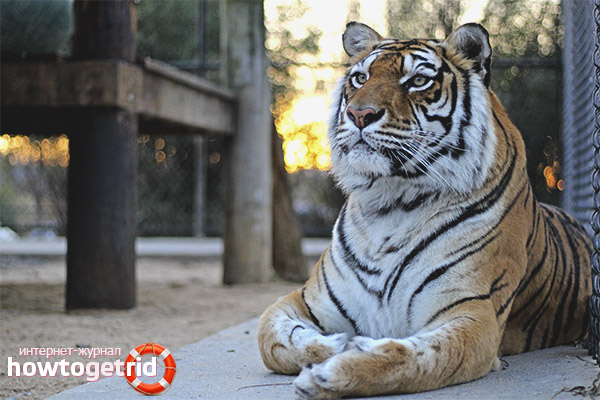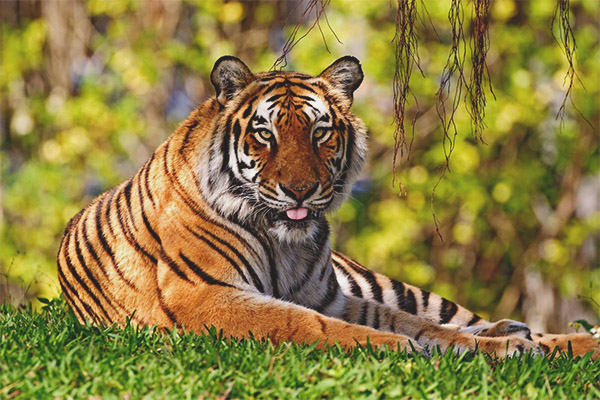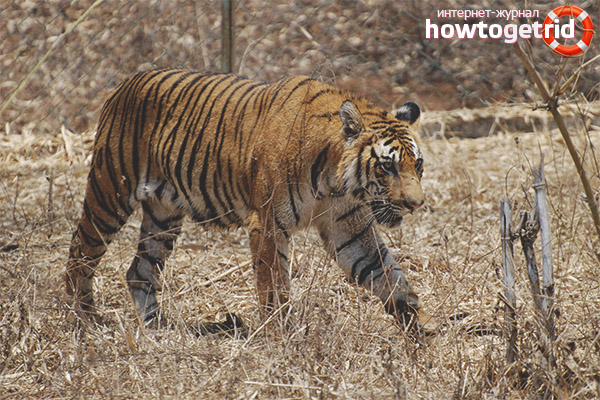The content of the article
The grace and majesty of the Bengal or royal tiger delights and amazes, but he would not like to meet on the way, neither people nor animals, so dangerous is this wild cat.
Features of the royal tiger
The color of this species is the largest tigers - from light yellow to orange or red, with black or dark brown stripes arranged longitudinally. The coat is snow-white. The tail is only one color: white, and against this background, along the entire length, are intricate black rings. It is quite long, accounting for a third of the total length, it happens that exceeds the meter length.
The muzzle is large and rounded, with wide, pointed ears. The size of the canines of a royal tiger is so huge that it can frighten even the most daring. They exceed 8 cm.
Eye color repeats body color.It means that animals can have yellow or red color. A tiger species with a white color has blue eyes, and their pupil is pink.
The language is a special organ of the Bengal tiger. It is long and mobile, and on the sides has tubercles. They are covered with cornified epithelium and help during the meal of the animal to separate the meat from the skeleton of the caught victim. And during washing they are also used very actively.
The body is powerful and flexible, with well developed muscles and a shoulder girdle, the same strong limbs. The claws are large and sharp, retractable. The hind legs are longer, and this is a great advantage of the tiger during the hunt, as it is convenient to jump on the victim. There are soft pads on their feet, so the tiger can appear silently. The length of the body, taking into account the tail, is from 2.5 to 4 m. Females are usually smaller, their sizes do not exceed 3 m.
The weight of the tigers is very impressive. The male has on average between 250 and 350 kg, and the females are much smaller, between 130 and 200 kg. The growth of tigers on average - 110 cm.
Habitats
The Bengal tiger considers the territories of such countries as India, Nepal, Myanmar, and, of course, Bangladesh, to be comfortable habitats in the past - Bengal. Most often, the tiger settles in tropical forests, because there you can always find a large amount of food, not far from water, along rivers such as the Ganges, Indus or Rabvi, because the climate prefers a humid, but at the same time hot. But they can live high in the mountains.
As the statistics show, this species is constantly decreasing every year, because it has been added to the Red Book as an endangered species. Those countries that have recognized this graceful and beautiful animal as a national treasure do not skimp on costs in order to preserve their populations, and most often due to protected areas. Special merit in this belongs to India and Bangladesh, where there are strict legal regulations for those who decide to kill a tiger.
Demeanor
In this animal power and courage, speed and strength are surprisingly combined. He is considered both wise and dangerous.
"Bengalis" do not recognize the noisy companies, because they live very separately. Having defined their territory, they will guard it all the time. So that the stranger knows that this zone is occupied, the tiger infinitely marks its borders.
Determined by its own territory based on how much game there is in this place. For females, this place covers about 20 km, but this is not enough for males, so they determine a territory of 100 km for themselves.
Weekday males are dedicated to the fact that they:
- Bypassing possession, vigilantly looking around. Suddenly, somewhere they will notice that someone has penetrated beyond the marked borders, then the expulsion of the stranger begins.
- Rest, especially if the hunt was productive. They like to sit comfortably, substituting the sun, to lick the wool. They can plunge into cool water, and cool for a long time.
- Go hunting. Once a potential prey appears somewhere, the tiger does not rush immediately ahead. Now his every movement is verified and clear. The tiger begins to pursue the unfortunate victim, gradually shortening the distance.The speed at the same time it develops an amazing - up to 65km / h. Usually the persecuted animal rushes about in search of refuge, managing to notify others that there is a danger. But here the tiger uses its weapon - a terrible roar. In this way, even at a great distance, he can cause the victim to be immobilized. Many animals are so scared that they are shocked and unable to move.
Tiger is practicing this way of hunting, when it tries silently to get to the animal at a distance of 10 m and jump on it, trying to immediately grab the throat. In this he is very helped by the dismembered form of coloring, which helps him successfully mask himself in the undergrowth.
In females, the lifestyle is not much different, but they have periods that are significantly different. This is the time of bearing the offspring, and then its feeding, courtship and upbringing. Then they have to be the most energetic, active in order to be able to feed not only themselves, but also tigers. In addition, one should be constantly alert and able to protect oneself and the young if the enemy attacks.
Tigers, who have lived to a great age, become weak.They no longer have the strength to catch up with the fast-moving living creatures or tear them apart (due to the lack of teeth). Therefore, they try to be as close as possible to human settlements. Many cases have been recorded when the “Bengali” attacked a person, and not everyone managed to escape from a hungry predator. They do not mind to eat and cattle.
Cattle are the most favorite food of this animal. Because often for lunch come across wild goats, bison or deer. But besides them, the tiger hunts wild boar, porcupine or large rodents, foxes, monkeys. They are not afraid to attack large predators, including the leopard and the wolf, the crocodile, the rhino and the jackal, as well as the elephant. If difficult times of hunger come, do not shun "Bengali" and carrion. Hunting can take place at any time of the day, it does not matter for a tiger, because his eyesight is excellent, hearing is well developed.
The tiger has a place for lunch in a certain secluded place, therefore, he can drag his victim in the teeth for many kilometers. At one time, this predator eats a fairly large amount of food - up to 40 kg. The remains of food in vain do not disappear. The beast hides them, covering it with grass, and then eats.
Tiger must drink a lot after a hearty meal. That is why instinct tells him that he should live near the water. In its designated area there is always a river or any body of water. Here you can always not only quench your thirst, but also plenty of swimming, and he swims very well. Hiding in the heat on the shallows - a favorite vacation.
Mating season

When the mating season comes, the male actively cares for the female living in the neighborhood, and then can only occasionally visit her and the born babies. But while the pregnant tigress is alone. Females can give birth once every 2 years, and during their life up to 20 tiger cubs appear, but many do not live to adulthood. The gestation period is short - 3.5 months. Usually from 3 to 5 babies are born who weigh no more than 1 kg. They are helpless and blind.
The first few months, babies get only breast milk, and then the mother begins to feed them meat. At this time, they sit in a safe shelter. Their mother had taken care to make a protective lair beforehand, and it could be in an inaccessible cave, reed supports, in places of windbreak or in crevices among the stones.
Tigress - mom is very caring. Thanks to her, the children comprehend the wisdom of hunting, learn to sit in ambush, attack, butcher the victim properly. When the offspring has grown up, and the mature period has come, the tigers leave the mother and leave in search of their own territory.
Video: Bengal tiger (Panthera tigris bengalensis)












To send